Abdelhamied Y Saad1*
1Professor and Head of Endodontic Department, Pharos University in Alexandria, Faculty of Dentistry, Egypt
Correspondence author: Bakopoulou Athina, BDS, MSc (Egypt), Ph.D., Endo. Cert. (USA), Professor and Head of Endodontic Department, Pharos University in Alexandria, Faculty of Dentistry, Egypt;
E-mail: [email protected]; [email protected]
Published Date: 23-04-2024
Copyright© 2024 by Saad AY. All rights reserved. This is an open access article distributed under the terms of the Creative Commons Attribution License, which permits unrestricted use, distribution, and reproduction in any medium, provided the original author and source are credited.
Abstract
The purpose of this educative work was to evaluate different techniques used for endodontic treatment of different pediatric cases including primary and young permanent teeth. The data of this investigation were obtained from some text books, endodontic researches, internet and personal data. Several techniques were utilized including indirect and direct pulp capping, pulpotomy, for vital pulps and pulpectomy for non-vital pulps. The results demonstrated successful outcome with long term follow-up. It was concluded that endodontic therapy can preserve dental arches, as well as the surrounding periodontium in good conditions and maintains the vitality of dental pulps of primary and young permanent teeth.
Keywords: Indirect and Direct Pulp Capping; Pulpotomy; Pulpectomy
Introduction
This teaching article collected from some endodontic text books, researches, internet, Google scholar database, Midline act. Others from my educative materials to make a complete story concerning “Endodontic Therapy for Primary and Young Permanent Teeth”. The dentin -pulp complex of the primary teeth has a similar response to dental caries as the permanent teeth. The treatment modalities for both also similar.
A Comparison of Primary and Permanent Tooth Anatomy
Fig. 1,2 showing the difference between the primary and permanent teeth.
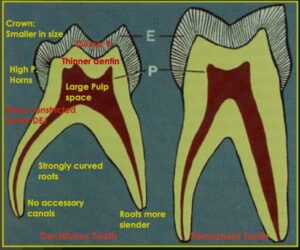
Figure 1: Showing the difference between deciduous and permanent teeth.

Figure 2: A and B: Caries can progress and infect the deciduous pulps more quickly than in permanent teeth.
Goal of Endodontic Therapy for Primary and Young Permanent Teeth
To maintain:
- An intact dental arch
- A healthy periodontium
- Vitality of dental pulp when possible
Pediatric endodontic therapy can be divided into:
- Vital therapy; includes indirect pulp capping, direct pulp capping and pulpotomy
- Root canal therapy; includes pulpectomy
Medical Factors in Determining if a Primary Tooth Should be Saved:
There are certain medical conditions that contraindicated endodontic therapy in the primary dentition.
Contraindications:
- Patients with congenital cardiac defects
- Immunosuppressed patients
- Patient who do not heal well e.g. uncontrolled diabetes or cancer patients
- Patients with severe medical conditions who must be treated with general anesthesia in an operating room
- Uncooperative children (extraction may be the treatment of choice)
Indications (To avoid extraction):
- Bleeding and coagulation disorder (e.g. hemophilia)
- Hypodontia in the permanent dentition (Fig. 3)
The type of endodontic therapy chosen must be based on the:
- Clinical diagnosis of normal pulp
- Reversible pulpitis
- Irreversible pulpitis
- Necrotic pulp

Figure 3: Primary 2nd molar with no successor has received RCT. Such teeth may last for many years.
Vital Pulp Therapy
- Indirect p. capping: Deep caries
- Direct p. capping: Vital pulp treatment
- Pulpotomy: Healthy or reversibly inflamed
- Pulp with deep caries and exposure
Treatment of Deep Caries (Indirect Pulp Capping)
- Deep carious lesion that very close to the pulp which would be exposed by caries excavation
- No signs or symptoms of irreversible pulpitis
The ultimate objective of this treatment is to maintain p. vitality by:
- Arresting the carious process
- Promoting dentin sclerosis (reducing permeability)
- Stimulating the formation of reparative dentin.
- Remineralizing the carious dentin (Fig. 4,5)
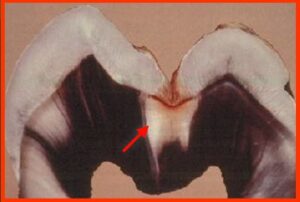
Figure 4: Enamel caries and sclerotic dentin (dye-filled dentinal tubules except sclerotic area – red arrow).
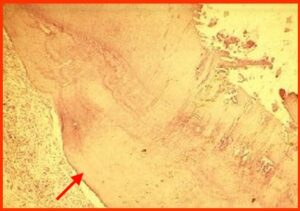
Figure 5: Reparative dentin (red arrow-H&E X25).
Treatment
- Careful removal of carious area except where there would be an exposure
- Dentin is covered by a Ca(OH)2 liner (Dycal), zinc phosphate base and amalgam (composite resin or GIC) with or without St. St. crown (Fig. 6-10)
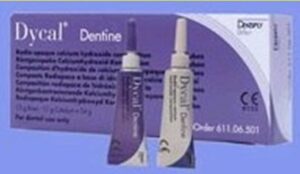
Figure 6: Dycal [CA (OH)2].
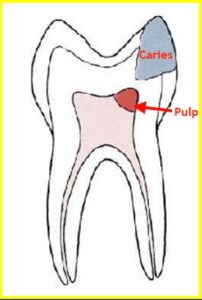
Figure 7: Coronal pulp tissue is inflamed even before the pulp is exposed.
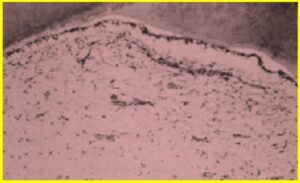
Figure 8: Note the early inflammatory changes in the odontoblast layer (H&E stain X25).
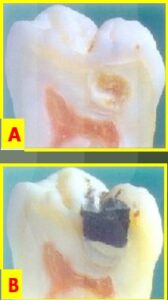
Figure 9: Indirect pulp capping (A and B).
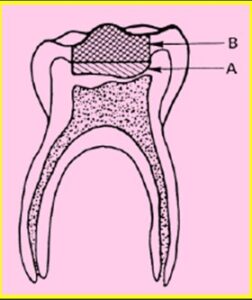
Figure 10: A: Ca(OH)2; B: lasting temporary restoration.
Post-operative evaluation can be performed by removing the amalgam and cement with sterile burs and rubber dam isolation, if:
- The dentin is hard and shiny
- The culture is sterile
- Radiograph showed evidence of reparative dentin formation
This means the remaining caries can then be removed successfully without pulp exposure. Scotchbond MultiPurpose can be used successfully for pulp protection instead of Ca(OH)2. Recently, the tooth can be restored with adhesive restorations (amalgam and St. St. crowns are becoming less desirable). The success rate is above 90%.
Criteria for Success
- No signs or symptoms consistent with reversible pulpitis
- Absence of clinical or radiographic lesions (internal or external resorption or furcation radiolucency)
- Complete removal of caries leaving only a small amount in the area where there would be an exposure
- Placement of a restoration that provide an excellent seal
Vital Pulp Therapy for Children (Direct Pulp Capping)
Is a treatment option for teeth with pinpoint-sized traumatic or mechanical vital pulp exposure with no signs or symptoms of irreversible pulpitis. The exposed pulp is covered by Ca(OH)2 or MTA and the tooth receives a permanent restoration (Fig. 11,12). Use rubber dam to prevent contamination.
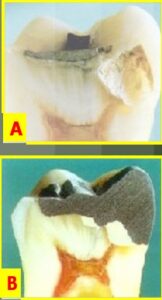
Figure 11: A and B: Direct pulp capping.
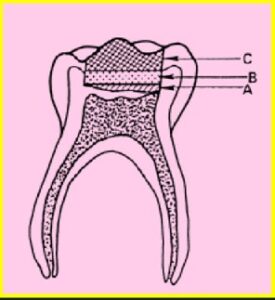
Figure 12: A: Ca(OH)2 or MTA; B: Protective base(ZOE); C: Amalgam restoration.
The patient should not experience any pain and reparative dentin is expected to form. Direct p. capping of a carious pulp exposure is not recommended (Fig. 13,14). It should be performed in older children where the tooth is not expected to last for more than a couple of years until normal exfoliation.

Figure 13: Caries exposes the pulp. Direct pulp capping is contraindicated.
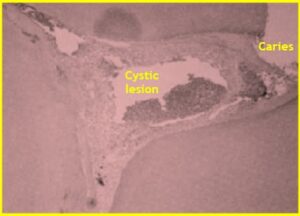
Figure 14: Inflammatory changes involving the entire pulp in response to proximal caries.
Pulpotomy
Is a procedure for teeth with healthy pulps or teeth with symptoms of reversible pulpitis and deep caries with pulp exposure.
- The coronal pulp is amputated leaving an intact vital radicular pulp
- The radicular pulp is treated with appropriate medicament
- The chamber filled with a suitable base (protective liner e.g. Ca(OH)2, a dentin bonding agent, Biodentine or GIC)
- The tooth is restored with a suitable restorative material (Fig. 15)

Figure 15: Deep caries removed and cavity preparation is performed for stainless steel crown prior to placement of a protective liner and the restoration.
Protective Liner
- Is a thinly applied flowable material, placed on the pulpal surface of a deep cavity preparation to cover the dentinal tubules after complete caries removal
- Act as defensive barrier between the restorative material and the pulp
- It will minimize post-operative sensitivity
- It will minimize microbial microleakage
- Promotes tissue healing and tertiary dentine formation
- Preserves the tooth’s vitality
Again, it is recommended that all pulp therapies be performed with a rubber dam. Clinical signs and symptoms should resolve within about 1-2 weeks. Tooth should remain asymptomatic exhibiting no pathologic mobility, sensitivity or pain.
Formocresol
Is the most common pulpotomy medicament used in pediatric dentistry today (Fig. 16).
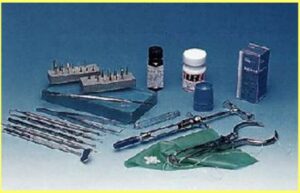
Figure 16: Armamentarium for the pulpotomy technique.
- For pulp exposure with inflammation confined to the coronal portion
- If inflammation has spread to the root canals, pulpectomy or extraction should be performed
Contraindications
- A non-restorable tooth
- A tooth nearing exfoliation (no bone overlying the permanent crown)
- A history of spontaneous toothache (not caused by pulpitis resulting from food impaction)
- Evidence of periapical or furcal pathosis
- A pulp that does not hemorrhage
- Inability to control hemorrhage after coronal pulp amputation
- A pulp with serous or purulent drainage
- The presence of fistula
Mechanism of Action
It acts through the aldehyde group of formaldehyde, forming bonds with the side-group of amino acids of both the bacterial proteins and remaining pulp tissue. Therefore;
- It is a bactericidal and devitalizing agent
- It kills off and converts bacteria and pulp tissue into inert compounds
- It also inactivates the oxidative enzymes in the pulp tissue adjacent to amputation side
- It may also have some effect on hyaluronidase action
Accordingly, the protein-binding properties and the inhibition of enzyme together results in:
- Fixation of the pulp tissue
- Render it inert
- Resistant to enzymatic breakdown
Clinical Procedures
Fig. 17-29 showing the technique used for teeth need formocresol pulpotomy.
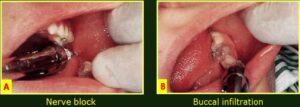
Figure 17: A and B: Administration of local anesthesia with the use of topical analgesic and then Isolate the tooth with rubber dam.
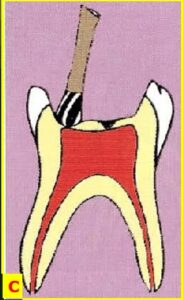
Figure 18: Caries removal with a slow- speed round, large and old bur.
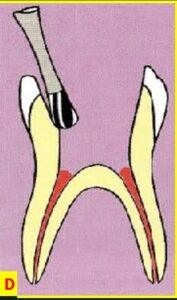
Figure 19: Removal of the roof with a high-speed bur and water spray.

Figure 20: Removal of the coronal pulp with a spoon excavator, then use hemostasis with sterile cotton pellets.

Figure 21: Formocresol is placed with slight pressure for 5 mins. (full- strength or diluted).
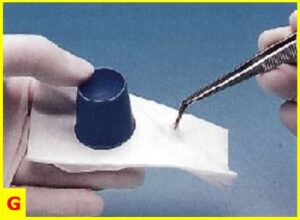
Figure 22: Apply formocresol for 5 min. (squeeze in gauze to remove excess).

Figure 23: Placement of ZOE base (after control of the bleeding).

Figure 24: Pulp chamber is filled with cement.

Figure 25: Restoration and stainless-steel crown.
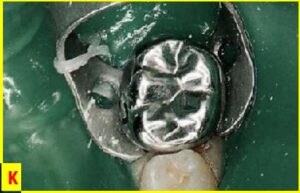
Figure 26: Stainless steel crown.
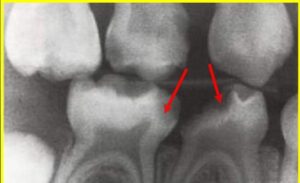
Figure 27: Pre-treatment radiograph showing deep caries.

Figure 28: One-year post-treatment radiograph.
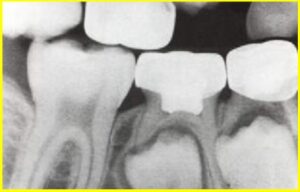
Figure 29: Five-year follow-up radiograph.
The Formocresol-treated pulp responded by 3 zones:
- Fixed eosinophilic tissue zone (at the amputated site)
- A pale zone with poor cellular definition (below the fixed zone) or necrotic zone
- Zone of chronically inflamed tissue (close to the apex)
Systemic distribution of formocresol to the liver, lung, muscles, heart, spleen, kidney was found (animal studies). Systemic absorption decreases by time indicating that it compromises the pulpal circulation and limits its systemic uptake. Some researchers have revealed the allergic effects (skin patch) as well as the mutagenic and carcinogenic potential of formocresol. Failure is usually detected in radiograph as
- Internal or external resorption.
- Apical or furcation radiolucency.
- Tooth mobility (with more destruction).
- Development of cystic lesion.
- Pain which is rare to occur (Fig. 30)

Figure 30: Formocresol pulpotomy failure (internal resorption with bifurcation radiolucency).
Glutaraldehyde
It was used in 1975 as an alternative pulpotomy fixed medicament. It is biologically accepted and capable to maintain the vitality of the radicular pulp. Several workers have stated that glutaraldehyde:
- Diffuse less out the apical foramen
- Has effective disinfecting properties
- Has better fixative properties
- Is absorbed into the systemic circulation
- Has low amount of tissue binding and the remainder is excreted in the urine
- Does not reach the nucleus of cells
- Has low mutagenic potential
- Penetrated deeper into the tissues (stronger concentration)
- Produces less allergic response than formocresol
- Causes no damage to permanent teeth
- Has clinical success rate with ZOE base ranged from 74 to 100% with time ranging from 6 to 24 months
- Has lower success rate with Ca(OH)2 base than pulpotomy using a ZOE base
- Less cytotoxic than formocresol
Applying glutaraldehyde directly to the pulp stump with medicated pellets for 5 mins., is better than incorporating it into the cement sub-base.
- A potential drawback to using glutaraldehyde is its limited shelf life
- It has been tested for many years and it appears that it is not the ideal material to replace formocresol in regard to safety
Freeze-Dried Bone
Few studies were performed using it as a pulpotomy agent using monkey’s primary teeth. Histologically;
- A complete or partial calcific barrier next to the pulp with normal odontoblasts were seen
- All the pulps were vital
- Researchers recommended it (clinical studies on human teeth)
Electrosurgery
Technique
- Access cavity preparation
- Pulp amputation
- Hemostasis with dry cotton pellets
- Pulp stump is treated with electrosurgical unit (for 1 second)
- Place a ZOE or Ca(OH)2 base and cover with restoration
Limit the amount of contact of the electrosurgical unit with pulp to prevent overheating of pulp tissue. Histologically;
- Tissue debris and coagulation necrosis on the pulp surface
- Increased fibrosis in the coronal pulp
- The apical pulp and furcation and periapical areas may remain normal to slightly fibrous
After few months, chronic inflammatory cells and fibroblasts with some reparative dentin can be seen below this area. However;
- Acute inflammation, edema and necrosis may be seen in the remaining pulp
- Pulp calcification in the coronal pulp may also be demonstrated
- Other teeth showed periapical or furcation pathosis
Many researchers do not recommend electrosurgical pulpotomy in spite it is faster and no risks of formocresol side effects.
Laser
- Argon, CO2 and Nd:YAG lasers are used to perform pulpotomy in animals and humans
- Clinical, radiographic and histologic evaluations have revealed that laser compares favorably to formocresol pulpotomies
- Laser may be considered as an alternative to formocresol for pulpotomy for primary teeth
Ferric Sulfate
It has been used as a hemostatic agent for crown and bridge impressions. In pulpotomy, a 15.5% solution is applied over the pulp stumps for 10 to 15 seconds. Fig. 31-33 showing clinical application of ferric sulfate. Histologically;
- Pulp necrosis in coronal pulp followed by inflammation and then reparative dentin formation
- The use of ZOE (irritant) or more inert base material is standard for this procedure
- It has a success rate similar to diluted formocresol or sometimes higher
- May cause calcific metamorphosis and internal resorption Fig. 34,35)
- Ferric sulfate and formocresol may also cause early exfoliation of the pulpotomized teeth (needs space maintainer)
- In this case a space maintainer is needed (Fig. 36)

Figure 31: Ferric sulfate.

Figure 32: Bleeding in the pulp chamber after coronal pulp amputation.

Figure 33: Bleeding arrested after application of ferric sulfate.
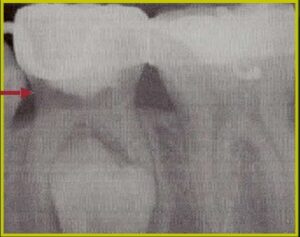
Figure 34: Radiograph showing internal resorption after ferric sulfate pulpotomy.
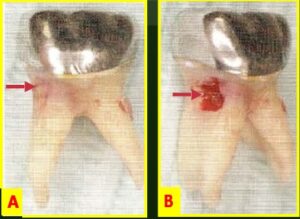
Figure 35: A photograph shown resorption resulted in perforation B.
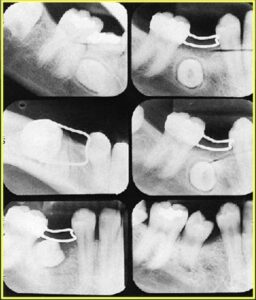
Figure 36: Space maintainer.
Mineral Trioxide Aggregate (MTA)
- Recently used (white or gray) in animal and human pulpotomy studies (Fig. 37-39)
- Dentin bridge is formed at the pulp-MTA interface and the pulp appeared normal
- Both MTA (white and gray) and Portland cement (regular and white) are good pulp capping agents
- Portland cement is less expensive but it is not approved for human use
- The gray MTA produces better results than the white
- MTA performs as a better than formocresol
- It has higher success rate and it lacks the undesirable side effects
- May cause pulp canal obliteration
- Expensive
Technique
- Amputation of the pulp from the pulp chamber
- The pulp chamber is covered by MTA paste (MTA powder mixed with water at a 3:1 powder to water ratio)
- This followed by a light-cured resin or GIC
- The tooth is then restored by St. St. crown
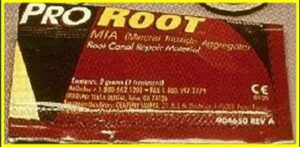
Figure 38: MTA (gray).

Figure 39: A and B: Showing mixing gray MTA.
Sodium Hypochlorite
At low concentrations it has been to be:
- Biocompatible
- Non-irritating and hemostatic to exposed pulp
- Able to eliminate bacteria, superficial inflamed tissue and dentin debris, while leaving the deeper tissue unharmed
Technique
- Removal of the coronal pulp.
- Achieving hemostasis.
- Placing cotton pellet saturated with 3% NaOCl for 30 seconds.
- Rinsing with sterile saline.
- Filling the pulp chamber with ZOE
The success rate for this treatment is similar to that of Formocresol.
Non-vital Pulp Therapy for Children (Pulpectomy)
Indication is when a tooth has irreversible pulpitis extending to the radicular pulp or has necrotic pulp. Treated by a pulpotomy and excessive hemorrhage (hyperemia) is encountered at the time of treatment. Presence of a chronic, draining sinus or an acute abscess with or without cellulites (Fig. 40-43).
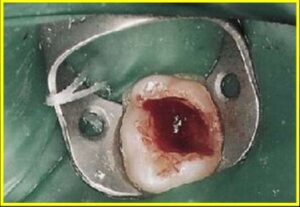
Figure 40: Irreversible inflammation extending to the radicular pulp.
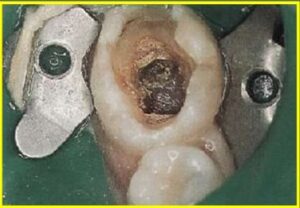
Figure 41: Necrotic pulp.

Figure 42: A chronic draining sinus (arrow) without cellulitis.

Figure 43: Acute periradicular abscess with cellulitis.
Contraindications
- A non-restorable tooth
- Internal resorption in the root visible on radiograph
- Teeth with mechanical or carious perforations of the floor of the pulp chamber
- Excessive pathologic root resorption involving more than one third of the root
- Excessive pathologic loss of bone support with loss of the normal periodontal attachment
- The presence of a dentigerous or follicular cyst
- The presence of periapical or inter-radicular lesion involving the crypt of the developing permanent successor (Fig. 44-47)

Figure 44: A non-restorable tooth (arrow).

Figure 45: Internal resorption with furcation radiolucency (arrow).
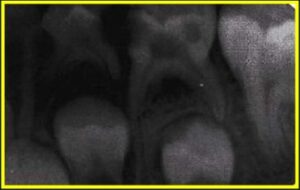
Figure 46: Advanced pathological root resorption. Extraction is the treatment of choice.
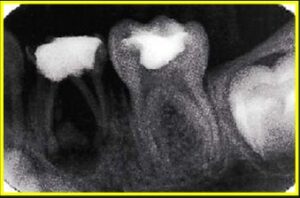
Figure 47: Primary tooth with furcation pathology.
Pulpectomy in Pediatric Dentistry Means:
- Removal of caries and diseased pulp
- Cleaning and shaping of the root canal
- Obturation with a resorbable material such as ZOE paste, iodoform paste, Ca(OH)2, Kri Paste or Vitapex (Fig. 48)
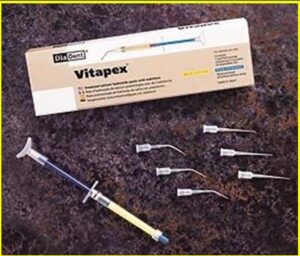
Figure 48: For obturation of root canal of the deciduous tooth.
- Kri Paste: A mixture of parachlorophenol, camphor, menthol and iodoform
- Vitapex: Commercially prepared calcium hydroxide and iodoform mixture that is pre-packed in syringes and considered the best
Clinical Procedure
- Fig. 49 showing the technique used for obturation with ZOE. Furthermore, Fig. 50-52 demonstrating a clinical case
- Pulpectomy must be done with a consideration for the subjacent succedaneous tooth by avoiding extending instruments into the apical area (Fig. 53)
- Chemo-mechanical debridement and obturation with gutta-percha should be performed in a retained deciduous molar with on successor to preserve the tooth in situ as long as we can (Fig. 54)
- Arrest of eruption of a permanent premolar after ZOE was extruded from the primary molar pulpotomy into the developing tooth bud
- Some authors have showed that pulpectomy had better success rate than formocresol or ferric sulfate pulpotomy.
- They added that it will be difficult to get the pediatric dental community to change because of the relatively high success rate of pulpotomy also, this was the treatment they learned
Pulpotomy is simple and some children are not cooperative enough to sit for pulpectomy procedure.
- Over- extension of resorbable cement [ZOE or Ca(OH)2] in the alveolus may occur after exfoliation of the primary tooth which may be resorbed late (Fig. 55,56)
- Despite the high success rate for the most properly treated teeth, the clinician must not ignore the follow-up. There is possibility for some complication and failure followed by serious consequences affecting the primary and the developing permanent dentitions
- Enamel hypoplasia or hypocalcification in succedaneous teeth may also occur. This is due to the close relationship between the erupted primary teeth and their permanent successors (Fig. 57-60)
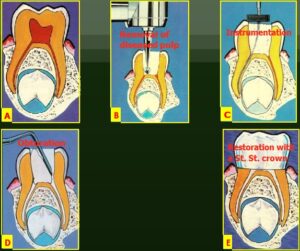
Figure 49: A-E: Obturation with ZOE.

Figure 50: Large carious lesion involving the pulp.

Figure 51: Obturation with ZOE.

Figure 52: One year later.

Figure 53: Care should be taken not to disturb the subjacent permanent tooth germ (arrow).

Figure 54: A and B: Pulpectomy and obturation with gutta- percha in a retained primary molar with no successor.

Figure 55: Primary incisor has been exfoliated (retained ZOE – arrow).

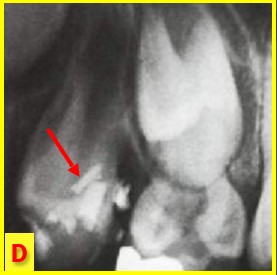

Figure 56: A-E: Pulpectomy & RCT filled with Ca(OH)2.

Figure 57: Enamel hypoplasia.
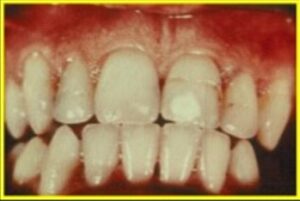
Figure 58: Enamel hypocalcification.
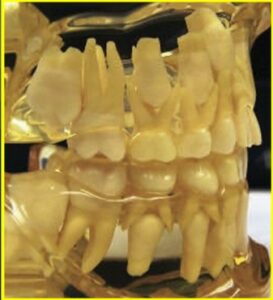
Figure 59: Close relationship between the erupted primary teeth and their permanent successors.
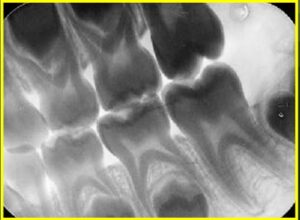
Figure 60: Bite-wing radiograph of the mixed dentition.
Conclusion
This educative research was conducted to discuss the role of the dental caries that affect the primary and young permanent teeth. If neglected, it may lead to pulp inflammation, pulp necrosis and un-restorable teeth followed by extraction. Subsequently, this may result in more detrimental effect on the dentition, pain, infection, periodontal diseases and loss of function.
This work was taken from some text books, endodontic researches, internet and personal data. Endodontic treatment to maintain the integrity of the teeth and supporting structures include indirect pulp capping, direct pulp capping and pulpotomy for vital pulps or pulpectomy for non-vital pulps. Favorable results were obtained and revealed that prevention or the early restoration minimizing the pulp inflammation, infections or extraction.
These findings demonstrated that correct endodontic treatment maintains the health of the teeth and surrounding tissues. This indicating that proper examination, early and accurate diagnosis of pulp condition, optimal definitive therapy and long-term follow-up should be the goal of endodontic therapy for deciduous and permanent teeth.
Conflict of Interests
The authors have no conflict of interest to declare.
References
- Bogen G, Dammaschke T, Chandler N. Vital pulp therapy: In Cohen’ pathway of the pulp. Elsevier: St. Louis, Misery. 2021;12(24):2844-2925.
- Bimstein E, Berdan YY. Engles endodontics. endodontic therapy in the pediatric patient. ingle’s endodontics. Chapter 38, PMPH-USA, Ltd., North Carolina. 2019;7(38):1147-180.
- Chen J, Jorden M. Materials for primary tooth pulp treatment: The present and future. Endod Topics. 2012:23:41-9.
- Ricketts D, Lamont T, Innes NP, Kidd E, Clarkson JE. Operative management in adult and children. Cochran Database Sys Rev. 2013;28:3:CD003808.
- McDonald RE, Avery DR, Dean JA. Treatment of deep caries, vital pulp exposure and pulpless teeth. Mcdonald and Avery’s Dentistry for the Child and Adolescent. 2010;9:343-65.
- American Academy of Pediatric Dentistry. Policy on medically necessary care. Reference manual. Pediatr Dent. 2014;36:18-22.
- About I. Recent trends in tricalcium silicates for vital pulp therapy. Curt Oral Health Rep. 2018;5:178-85.
- Akhlaghi N, Kademi A. Outcomes of vital pulp therapy in permanent teeth with different medicaments based on review of the literature. Dent Res J (Isfahan). 2015;12(5):406-17.
Article Type
Review Article
Publication History
Received Date: 01-04-2024
Accepted Date: 15-04-2024
Published Date: 23-04-2024
Copyright© 2024 by Saad AY. All rights reserved. This is an open access article distributed under the terms of the Creative Commons Attribution License, which permits unrestricted use, distribution, and reproduction in any medium, provided the original author and source are credited.
Citation: Saad AY. Endodontic Therapy for Primary and Young Permanent Teeth (Pediatric Endodontics). J Dental Health Oral Res. 2024;5(1):1-31.

Figure 1: Showing the difference between deciduous and permanent teeth.

Figure 2: A and B: Caries can progress and infect the deciduous pulps more quickly than in permanent teeth.

Figure 3: Primary 2nd molar with no successor has received RCT. Such teeth may last for many years. 
Figure 4: Enamel caries and sclerotic dentin (dye-filled dentinal tubules except sclerotic area – red arrow).

Figure 5: Reparative dentin (red arrow-H&E X25).

Figure 6: Dycal [CA (OH)2].

Figure 7: Coronal pulp tissue is inflamed even before the pulp is exposed.

Figure 8: Note the early inflammatory changes in the odontoblast layer (H&E stain X25).

Figure 9: Indirect pulp capping (A and B).

Figure 10: A: Ca(OH)2; B: lasting temporary restoration.

Figure 11: A and B: Direct pulp capping.

Figure 12: A: Ca(OH)2 or MTA; B: Protective base(ZOE); C: Amalgam restoration.

Figure 13: Caries exposes the pulp. Direct pulp capping is contraindicated.

Figure 14: Inflammatory changes involving the entire pulp in response to proximal caries.

Figure 15: Deep caries removed and cavity preparation is performed for stainless steel crown prior to placement of a protective liner and the restoration.

Figure 16: Armamentarium for the pulpotomy technique.

Figure 17: A and B: Administration of local anesthesia with the use of topical analgesic and then Isolate the tooth with rubber dam.

Figure 18: Caries removal with a slow- speed round, large and old bur.

Figure 19: Removal of the roof with a high-speed bur and water spray.

Figure 20: Removal of the coronal pulp with a spoon excavator, then use hemostasis with sterile cotton pellets.

Figure 21: Formocresol is placed with slight pressure for 5 mins. (full- strength or diluted).

Figure 22: Apply formocresol for 5 min. (squeeze in gauze to remove excess).

Figure 23: Placement of ZOE base (after control of the bleeding).

Figure 24: Pulp chamber is filled with cement.

Figure 25: Restoration and stainless-steel crown.

Figure 26: Stainless steel crown.

Figure 27: Pre-treatment radiograph showing deep caries.

Figure 28: One-year post-treatment radiograph.

Figure 29: Five-year follow-up radiograph.

Figure 30: Formocresol pulpotomy failure (internal resorption with bifurcation radiolucency).

Figure 31: Ferric sulfate.

Figure 32: Bleeding in the pulp chamber after coronal pulp amputation.

Figure 33: Bleeding arrested after application of ferric sulfate.

Figure 34: Radiograph showing internal resorption after ferric sulfate pulpotomy.

Figure 35: A photograph shown resorption resulted in perforation B.

Figure 36: Space maintainer.

Figure 37: MTA (white).

Figure 38: MTA (gray).

Figure 39: A and B: Showing mixing gray MTA.

Figure 40: Irreversible inflammation extending to the radicular pulp.

Figure 41: Necrotic pulp.

Figure 42: A chronic draining sinus (arrow) without cellulitis.

Figure 43: Acute periradicular abscess with cellulitis.

Figure 44: A non-restorable tooth (arrow).

Figure 45: Internal resorption with furcation radiolucency (arrow).

Figure 46: Advanced pathological root resorption. Extraction is the treatment of choice.

Figure 47: Primary tooth with furcation pathology.

Figure 48: For obturation of root canal of the deciduous tooth.

Figure 49: A-E: Obturation with ZOE.

Figure 50: Large carious lesion involving the pulp.

Figure 51: Obturation with ZOE.

Figure 52: One year later.

Figure 53: Care should be taken not to disturb the subjacent permanent tooth germ (arrow).

Figure 54: A and B: Pulpectomy and obturation with gutta- percha in a retained primary molar with no successor.

Figure 55: Primary incisor has been exfoliated (retained ZOE – arrow).



Figure 56: A-E: Pulpectomy & RCT filled with Ca(OH)2.

Figure 57: Enamel hypoplasia.

Figure 58: Enamel hypocalcification.

Figure 59: Close relationship between the erupted primary teeth and their permanent successors.

Figure 60: Bite-wing radiograph of the mixed dentition.


